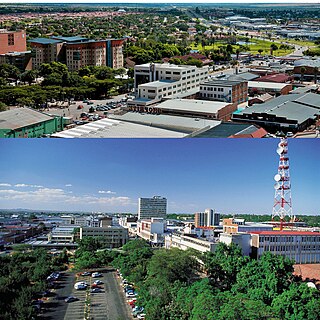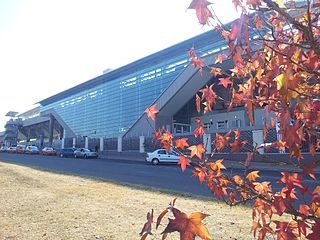
Pretoria, also known as Tshwane, is South Africa's administrative capital, serving as the seat of the executive branch of government, and as the host to all foreign embassies to South Africa.

Polokwane, formerly and sometimes also known as Pietersburg, is the capital city of the Limpopo Province in South Africa. It is the country's largest urban centre north of Gauteng. It was one of the nine host cities of the 2010 FIFA World Cup.

Centurion is an area with 236,580 inhabitants in the Gauteng Province of South Africa, between Pretoria and Midrand. Formerly an independent municipality, with its own town council, it has been part of the City of Tshwane Metropolitan Municipality since 2000. Its heart is at the intersection of the N1 and N14 freeways. The R21 freeway also passes through the eastern part of Centurion.

Midrand is a former municipality in central Gauteng, South Africa. Situated in-between Centurion and Sandton, Midrand now forms part of the City of Johannesburg Metropolitan Municipality.

Randburg is an area located in the Gauteng province of South Africa. Formerly a separate municipality, its administration devolved to the newly created City of Johannesburg Metropolitan Municipality, along with neighbouring Sandton and Roodepoort, in the late 1990s. During the transitional period of 1996–2000, Randburg was part of the Northern Metropolitan Local Council (MLC).

Brits is a town in the North West Province of South Africa. It is situated in a fertile citrus, vegetable and grain-producing area that is irrigated by the waters of the Hartbeespoort Dam. It is close to the City of Tshwane Metropolitan Municipality in Gauteng, which includes Pretoria, and it has the same dialling code as Pretoria. In addition to being a centre for agriculture, the city is home to several heavy industries. A factory of the Italian car manufacturer Alfa Romeo produced cars for the domestic market and export to Asia from 1974 to 1985. The city also plays an important role in the South African mining industry: 94% of South Africa's platinum comes from the Rustenburg and Brits districts, which together produce more platinum than any other single area in the world. In addition, there is a large vanadium mine in the district.

Vereeniging is a city located in the south of Gauteng province, South Africa, situated where the Klip River empties into the northern loop of the Vaal River. It is also one of the constituent parts of the Vaal Triangle region and was formerly situated in the Transvaal province. The name Vereeniging is the Dutch word meaning "association".

Springs is a former independent city that is now part of the City of Ekurhuleni, based in the east of Johannesburg, in Gauteng Province, South Africa. It lies 50 km (31 mi) east of Johannesburg and 72 km (45 mi) southeast from Pretoria. Its name derives from the large number of springs in the area, and its estimated population is more than 121,610 in 2011. It is situated at 1628 m (5,340 ft) above sea level.

Strand is a seaside resort town in the Western Cape, South Africa. It forms part of the Eastern Suburbs of the City of Cape Town Metropolitan Municipality, situated on the north-eastern edge of False Bay and near the foot of the Helderberg Mountains. Its geographical position is between Somerset West and Gordon's Bay, and is about 50 km southeast of Cape Town City Bowl. Strand has a population of approximately 50,000. Strand's main attraction is the beach; 5 km of white sandy beach off False Bay.
Randpark is a suburb of Randburg, South Africa. It is located in the northern suburbs of the City of Johannesburg.
Menlo Park is an upmarket suburb in the city of Pretoria, South Africa. It borders other upmarket areas Waterkloof, Brooklyn and Lynnwood. When it was first established between the 1950s and 1960s, it was the most eastern suburb of Pretoria, but the city has since considerably expanded eastwards. Today these suburbs are known as the Old East and can boast to have some of the city's most high-end residential properties.

Pretoria North is a suburb of the city of Pretoria, Gauteng, South Africa, with a population of 16,972 people according to the 2011 census.
The R566 is a Regional Route in South Africa that connects Brits with Pretoria North via Ga-Rankuwa and Rosslyn.

Rosslyn is an industrial suburb of Akasia, 29 km north-west of Pretoria and part of the City of Tshwane Metropolitan Municipality in the Gauteng province of South Africa.
Garsfontein is a residential suburb of the city of Pretoria in the Gauteng province of South Africa. It is a well-developed area, lying to the east of the city centre, close to the Menlyn Park shopping center.
The following is a timeline of the history of Pretoria, in the City of Tshwane Metropolitan Municipality, Gauteng province, South Africa.
Danville is a predominantly White suburb, to the west of central Pretoria, in the City of Tshwane Metropolitan Municipality.

Capital Park is one of Pretoria's oldest and first suburbs and lies approximately 4 km north of the historic Church Square, behind the Pretoria National Zoo. The neighbourhood is bordered by the Witwatersberge on the south side and the Apies River on the west side. The neighbourhood extends from the Apies River to Johan Heyns Drive. Streets in the neighbourhood are named after early mayors of Pretoria. One of the former mayoral residences is in Capital Park. Capital Park was previously a very popular neighbourhood among Italian as well as Portuguese communities – the Portuguese Church is still in Van Heerden Street (2010). The residential area today is cosmopolitan, with predominantly Afrikaans speaking inhabitants. The CPRTA functions as residents' association to look after the interests of its residents.
The M20 road is a metropolitan route in the City of Tshwane in Gauteng, South Africa. It connects Akasia with Hebron via Soshanguve.















